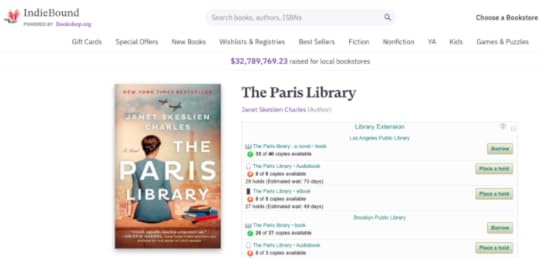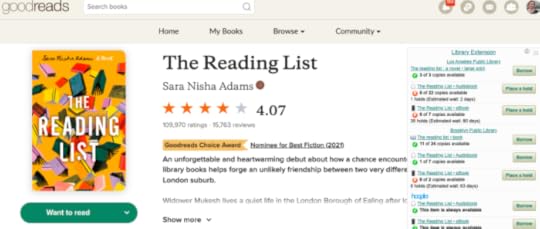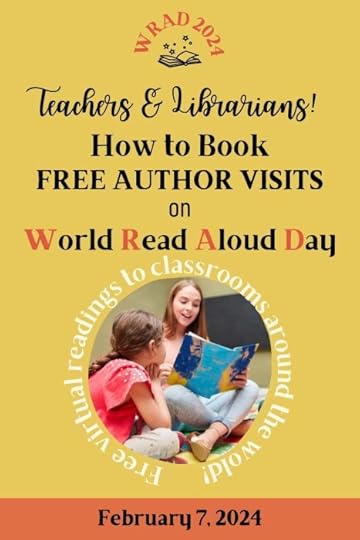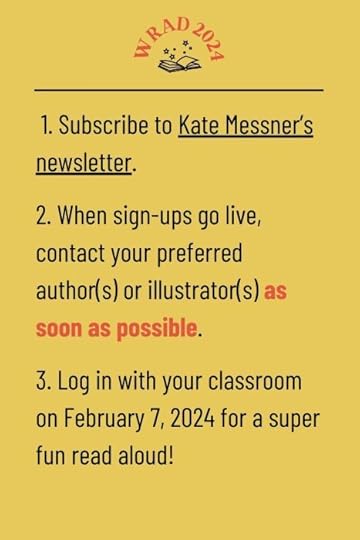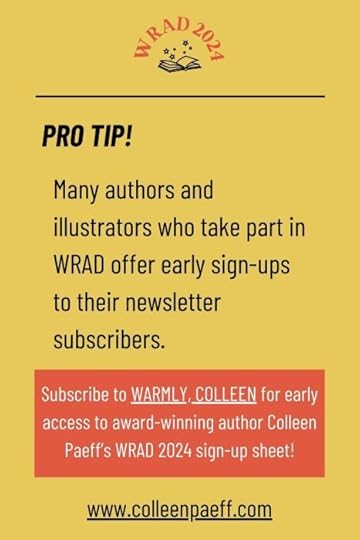Colleen Paeff's Blog
August 30, 2024
The ONE Tool Every Book Nerd Needs
Hello, fellow Book Nerds, Book Lovers, Writers, Readers, and other People of the Book!

art by Allie Brosh
I am about to change your life. Ok, that might be a bit hyperbolic, but I am 100% going to save you time and money.
I’d like to introduce you to Library Extension, a free browser extension (available for Chrome, Firefox, and Edge) that automatically – and instantly – tells you if a book or ebook you’re viewing on a retail site, or on Goodreads, is available at your local library.
Now listen, I’m not saying we shouldn’t BUY ALL THE BOOKS. But when we shop in brick and mortar bookstores, we preview the book, right? We hold it in our hands, turn it over a couple times, open it up and take a good whiff of the pages. We probably even read a few of those pages. But we lose much of that experience when we shop online.
That’s where Library Extension comes in. Once it’s installed on your browser, if you’re looking at a book online and you’re not 100% sure it’s a book you want to own, you’ll know right away if your library has a copy.
Or this…
If your library does have an available copy, just click on the borrow button (see it there on the right?) and you’ll be taken directly to your library’s website to put it on hold. Easy peasy!
Library Extension supports over 5,000 libraries and you can add multiple library catalogs to your account, so it searches multiple library catalogs at once. I’m telling you, it’s magic. (If you’re committed to borrowing rather than buying, WorldCat also searches multiple libraries at once. Check it out!)
As a writer of nonfiction for kids, I do a lot of research and I often start by checking to see what books are available on Amazon. But I don’t want to spend money on a book that doesn’t have the information I need, so I almost always borrow a book from the library before making a purchase. Library Extension makes that super easy and, sometimes, instantaneous. If an ebook version of the book I’m viewing is available from the library, I download it to my Kindle app immediately. (You can download the Kindle app for free on iOS Android, Mac, and PC. You don’t need to own the Kindle device anymore.)
So, there you have it! Here’s a link to some Library Extension FAQs and a video on How to Install Library Extension. It’s really simple.
I hope you use it and love it, just like I do!
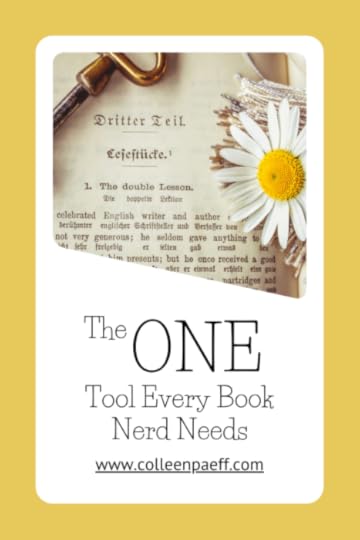
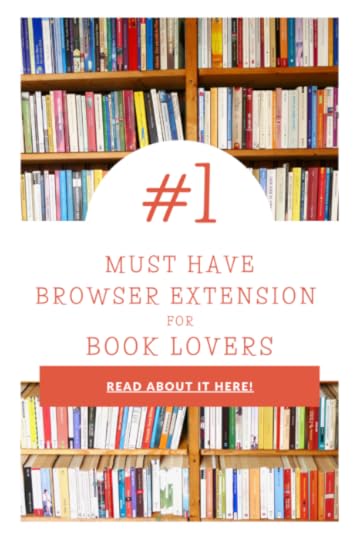
The post The ONE Tool Every Book Nerd Needs appeared first on Colleen Paeff.
August 26, 2024
An Anniversary Giveaway!
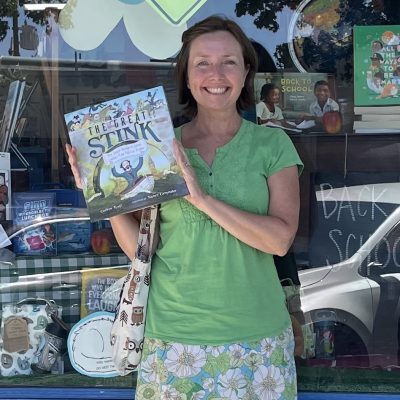 August 31, 2024 marks the third anniversary of the publication of
The Great Stink
and I’ve come up with a fun way to celebrate that allows me to get to know you and your work, while supporting my local independent bookstore, Once Upon a Time, in Montrose, CA.
August 31, 2024 marks the third anniversary of the publication of
The Great Stink
and I’ve come up with a fun way to celebrate that allows me to get to know you and your work, while supporting my local independent bookstore, Once Upon a Time, in Montrose, CA.Here’s how it works:
1. You buy TWO COPIES of The Great Stink from Once Upon a Time (and ONLY Once Upon a Time–this offer is NOT available if you purchase your books elsewhere) by September 15.
2. You email your receipt to colleen@colleenpaeff.com.
And then…
3. I give you a FREE PICTURE BOOK MANUSCRIPT CRITIQUE! (Up to 1000 words, one critique per person, and no rhyming text, please)
Exciting, right!?
Here’s some information that should make this whole process pretty easy (fingers crossed!) The page where you place your order for two copies of The Great Stink should look like the picture below. If it doesn’t look like that you’re at the wrong bookstore. Scroll away!
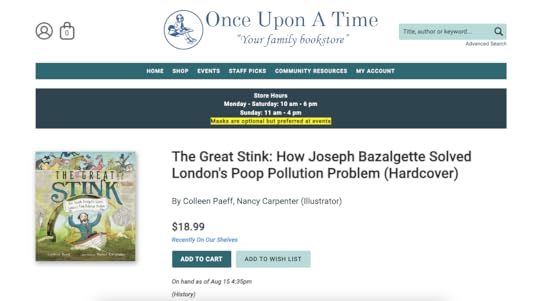 If you want to receive the two copies yourself, just fill out the requested information, as usual.
If you want to receive the two copies yourself, just fill out the requested information, as usual.If you want me to sign the copies, scroll to the bottom of the page, and in the “Order comments” section, let them know to whom I should inscribe the books. If you’d rather I simply signed my name, just write “Autograph only.” If you don’t want the books signed, leave that space blank.
If you already have the book and/or you don’t want to receive any copies, I will donate them to a wonderful organization, called Access Books. They provide books (and libraries!) to schools serving low-income students in California.If this is the case, check the box on the order form that says, “I would like to pick this book up in store…”. It looks like this:
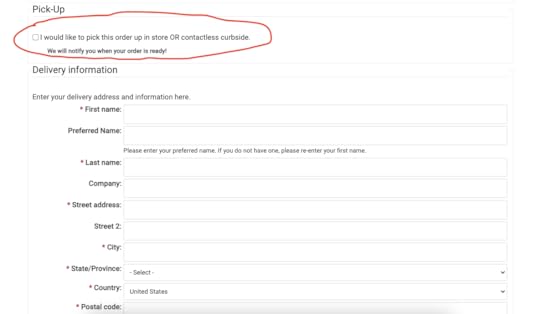 Then scroll down and under “Order comments” let them know I will pick the books up and donate them to Access Books for you. (Please don’t judge my wonky oval. LOL. I’m a writer, not an illustrator!)
Then scroll down and under “Order comments” let them know I will pick the books up and donate them to Access Books for you. (Please don’t judge my wonky oval. LOL. I’m a writer, not an illustrator!)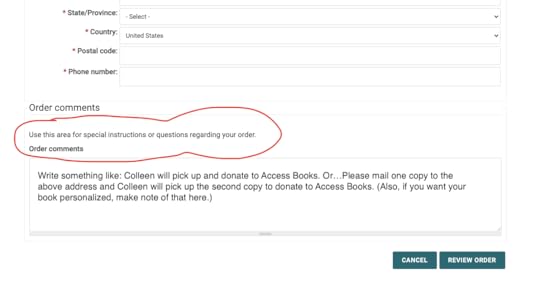 If you want to receive one book and donate the other, call the store at (818) 248-9668 and place your order over the phone. If the person on the phone is confused, ask to speak to Maureen or Jessica. They’ll know what’s going on.
If you want to receive one book and donate the other, call the store at (818) 248-9668 and place your order over the phone. If the person on the phone is confused, ask to speak to Maureen or Jessica. They’ll know what’s going on.If you have questions I haven’t answered, email me at colleen@colleenpaeff.com and I’ll get back to you after August 24.
Thank you, in advance, for supporting independent bookstores (and me!)!! I look forward to reading your work!Click here to order The Great Stink from Once Upon a TimeThe post An Anniversary Giveaway! appeared first on Colleen Paeff.
December 13, 2023
The Best Nonfiction Books About Poop (for Kids of All Ages)
What is it with kids and poop? Why do they think it’s so hilarious?! I don’t have an answer for you, but I do have a list of the ten best books for poop-obsessed kids. Call it a gift guide. Call it a recommended reading list. Call it a resource for teachers and librarians. These books don’t resort to potty humor. They are thoroughly researched, nonfiction books that use poop (and sometimes toilets) as a gateway to STEM subjects like biology, engineering, environmental science, and wastewater treatment – with a healthy dose of history.
You will be the coolest grown-up around if you get a kid in your life a book about poop. And the kids will be so thrilled to be reading about this taboo subject, they won’t even know they’re learning!
I’ve organized the books by age, youngest to oldest. The links I’ve provided go to Worldcat.org (a worldwide library catalog) so you can find out if your local library has the book. In most cases Worldcat also provides a variety of links to outlets where you can buy the books as well. Here we go…
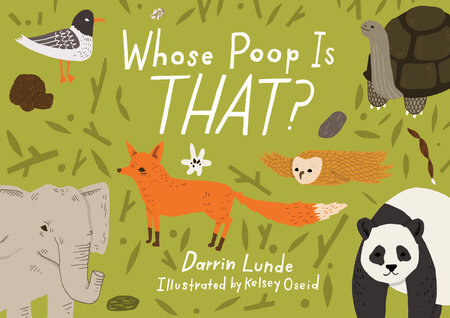 Whose Poop is THAT? by Darrin Lunde and Kelsey Oseid (3-7 years)
Whose Poop is THAT? by Darrin Lunde and Kelsey Oseid (3-7 years)Part book, part guessing game, Whose Poop is That? combines two topics beloved of toddlers everywhere – poop and animals. Here’s the publisher’s summary:
Poop! Ewwww!
No, don’t say “Ewwww.” Ask, “Whose poop is that?” This simple, and yes, charming book asks this question about seven examples of animal poop. By investigating visual clues, young readers can learn to identify the animal through its droppings. For instance, find a sample of poop with bits of bone and tufts of hair. Turn the page to learn it came from a fox!
Kelsey Oseid’s illustrations are both accurate and beautiful. Backmatter includes further information about the poop and what scientists can learn from an animal’s droppings.
 What Do They Do With All That Poo? by Jane Kurtz and Allison Black (4-8 years)
What Do They Do With All That Poo? by Jane Kurtz and Allison Black (4-8 years)I’m embarrassed to say that after all the time I’ve spent pondering poo (it comes with the territory when you write a book about sewers!), I had never stopped to wonder what zoos do with the prodigious amounts of poo generated by their animals until I saw this book. In jaunty, rhyming text (with sidebars full of additional fun facts) this books answers that question. Here’s a summary from the publisher:
Find out what happens to all of the poo at the zoo in this funny and factual picture book!
There are so many different kinds of animals at the zoo, and they each make lots and lots (and sometimes LOTS!) of poo. So what do zoos do with all of that poo? This zany, fact-filled romp explores zoo poo, from cube-shaped wombat poo to white hyena scat, and all of the places it ends up, including in science labs and elephant-poo paper—even backyard gardens!
Jane has also written a more recent book called The Clues are in the Poo. I couldn’t get my hands on a copy in time for this blog post, which is why it’s not on the list but I just put it on hold at the library and I can’t wait to read it! The book introduces readers to scientist Karen Chin as she hunts for fossilized dinosaur poop. It’s another fabulous combo – dinosaurs and poop! What kid wouldn’t want to read about that?
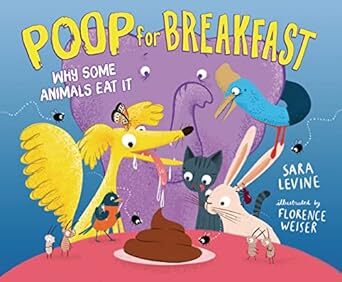 Poop for Breakfast: Why Some Animals Eat It by Sara Levine and Florence Weiser (4-8 years)
Poop for Breakfast: Why Some Animals Eat It by Sara Levine and Florence Weiser (4-8 years)I’ve had two dogs that (to my absolute horror) considered cat poop a tasty treat, but I had no idea there were other animals that ate poop, until I read this book. (As you can see, I learn A LOT from picture books!) Poop for Breakfast will have you and your kids marveling at Mother Nature’s ingenuity, even as you wrinkle your noses in disgust. Here’s the publisher’s summary:
Eating poop is gross! So why do some animals do it? For lots of good reasons!
Male butterflies slurp up poop to give as a gift to females, which makes their eggs stronger. Robins scarf down the poop of young chicks because it’s full of undigested nutrients. And baby elephants gobble up the poop from adults to get essential bacteria into their digestive systems. This disgustingly informative book is bursting with lots of surprising information about animals—and digestion!
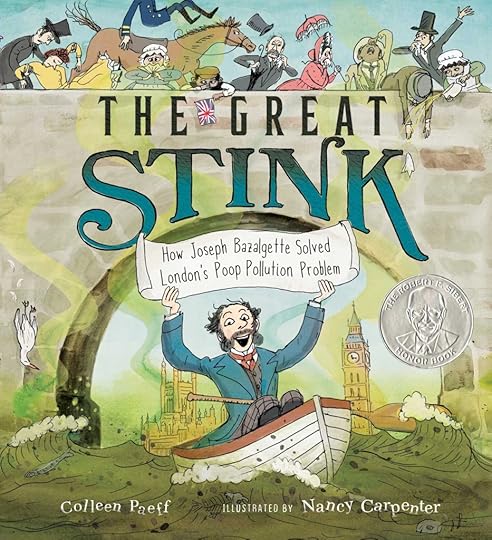 The Great Stink: How Joseph Bazalgette Solved London’s Poop Pollution Problem by Colleen Paeff and Nancy Carpenter (5-10 years)
The Great Stink: How Joseph Bazalgette Solved London’s Poop Pollution Problem by Colleen Paeff and Nancy Carpenter (5-10 years)When I visit young readers on school visits, one of the questions I most often get asked is, “Why did you want to write a book about poop?” It’s a fair question! But I always answer that I never really thought of The Great Stink as a book about poop. It’s about pollution and engineering and sewers and persistence and making one city a better, safer place to live – and it happens to feature quite a bit of poop. (It’s also full of synonyms for poop! See how many you can find in the text. It’s fun!) Here’s the publisher’s summary:
Discover the true story about the determined engineer who fixed London’s pollution problem in this funny, accessible nonfiction picture book featuring engaging art from the illustrator of Queen Victoria’s Bathing Machine.
It’s the summer of 1858, and London’s River Thames STINKS. What is creating this revolting smell? The answer is gross: the river is full of poop.
But the smell isn’t the worst problem. Every few years, cholera breaks out, and thousands of people die. Could there be a connection between the foul water and the deadly disease?
One engineer dreams of making London a cleaner, healthier place. His name is Joseph Bazalgette. His grand plan to create a new sewer system to clean the river is an engineering marvel. And his sewers will save lives. Nothing stinky about that.
With tips for how to prevent pollution today, this fascinating look at science, history, and what one person can do to create change will impress and astound readers who want to help make their planet a cleaner, happier place to live.
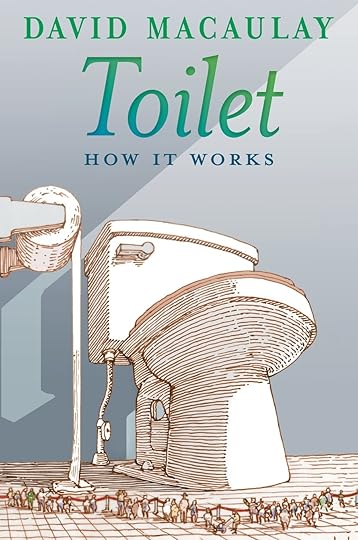 Toilet: How It Works by David Macaulay (5-10 years)
Toilet: How It Works by David Macaulay (5-10 years)We all know David Macaulay can make absolutely anything interesting. But what you may not know, is that toilets, sewers, and wastewater treatments facilities were already interesting! Add in some David Macaulay magic and you’ve got one heck of a good book. Toilet: How it Works is aimed at newly independent readers, but it’s full of information all readers will appreciate. Here’s a summary from the publisher:
Everyone knows what a toilet is for, right? But what exactly happens after you flush? Where does our waste go, and how is it made safe? With his unique blend of informative text and illustration, David Macaulay takes readers on a tour of the bathroom and the sewer system, from the familiar family toilet to the mysterious municipal water treatment plant.
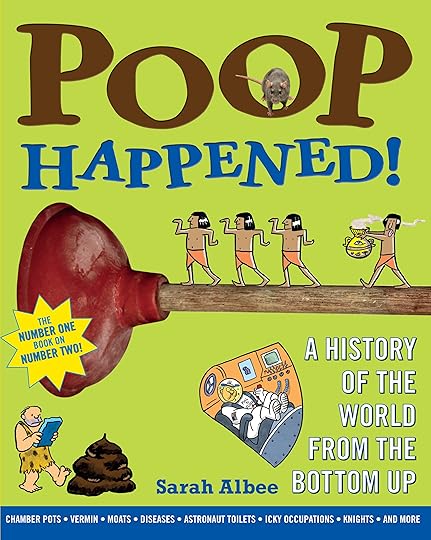 Poop Happened: A History of the World from the Bottom Up by Sarah Albee and Robert Leighton (7-11 years)
Poop Happened: A History of the World from the Bottom Up by Sarah Albee and Robert Leighton (7-11 years)I cannot tell you how much I love this book. The recommended age group is 7 to 11, but it’s just as fascinating for adults as it is for kids. Seriously, this is one of those books that answers all kinds of questions you didn’t even know you had. Here’s the publisher’s summary:
Did lead pipes cause the fall of the Roman Empire?
How many toilets were in the average Egyptian pyramid?
How did a knight wearing fifty pounds of armor go to the bathroom?
Was poor hygiene the last straw before the French Revolution?
Did Thomas Crapper really invent the modern toilet?
How do astronauts go in space?
History finally comes out of the water-closet in this exploration of how people’s need to relieve themselves shaped human development from ancient times to the present. Throughout time, the most successful civilizations were the ones who realized that everyone poops, and they had better figure out how to get rid of it! From the world’s first flushing toilet invented by ancient Minoan plumbers to castle moats in the middle ages that used more than just water to repel enemies, Sarah Albee traces human civilization using one revolting yet fascinating theme.
A blend of historical photos and humorous illustrations bring the answers to these questions and more to life, plus extra-gross sidebar information adds to the potty humor. This is bathroom reading kids, teachers, librarians, and parents won’t be able to put down!
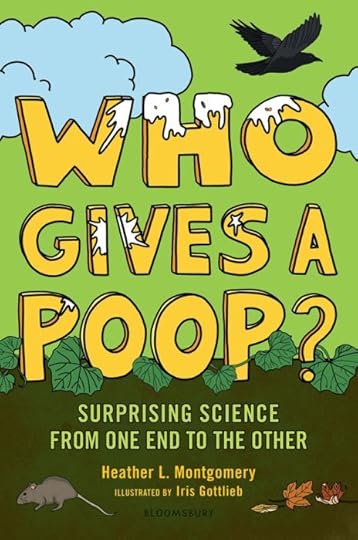 Who Gives a Poop? Surprising Science from One End to the Other by Heather L. Montgomery and Iris Gottlieb (10-14 years)
Who Gives a Poop? Surprising Science from One End to the Other by Heather L. Montgomery and Iris Gottlieb (10-14 years)Heather Montgomery (whose books I love!) follows her curiosity to all kinds of interesting places and as her lucky readers we get to come along for the ride and it’s absolutely fascinating! Here’s a description from the publisher:
Follow scientist Heather L. Montgomery into science labs, forests, hospitals, and landfills, as she asks: Who uses poo?
Poop is disgusting, but it’s also packed with potential. One scientist spent months training a dog to track dung to better understand elephant birthing patterns. Another discovered that mastodon poop years ago is the reason we enjoy pumpkin pie today. And every week, some folks deliver their own poop to medical facilities, where it is swirled, separated, and shipped off to a hospital to be transplanted into another human. There’s even a train full of human poop sludge that’s stuck without a home in Alabama!
This irreverent and engaging narrative nonfiction book shows that poop isn’t just waste – and that dealing with it responsibly is our duty.
 How the Toilet Changed History by Laura Perdew (10-14 years)
How the Toilet Changed History by Laura Perdew (10-14 years)I used this book in my research for The Great Stink and I was super excited one afternoon at a writing conference to find myself seated next to its author, Laura Perdew, who was absolutely delightful. In the book, Laura gives an in depth look at the incredible changes brought about by the toilet and everything that came along with it. This book was written for the education market, so look for it at your library. After reading this book you will thank your lucky stars for the toilet, plumbing, and sanitation systems that make it possible to forget our waste once its flushed! This summary (from Amazon) is pretty dry, but here you go:
How the Toilet Changed History examines the invention of the toilet and explores how improving sanitation has changed cities and human health.
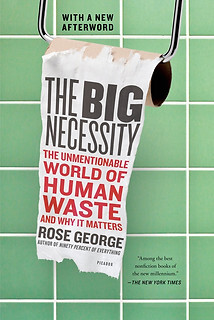 The Big Necessity: The Unmentionable World of Human Waste and Why it Matters by Rose George (12 to adult)
The Big Necessity: The Unmentionable World of Human Waste and Why it Matters by Rose George (12 to adult)I know you’re all long past the stage when poop was something you wanted to think about, but I am telling you…this book is a MUST READ.
The publisher does a fine job of explaining why, so I’ll leave you with their description:
Bonus BookBodily waste is common to all and as natural as breathing. We prefer not to talk about it, but we should—even those of us who take care of our business in pristine, sanitary conditions. Disease spread by bodily waste kills more people worldwide every year than any other single cause of death. Even in the United States, nearly two million people have no access to an indoor toilet, while the sewers of major cities worldwide are an infrastructure disaster waiting to happen. With razor-sharp wit and crusading urgency, mixing levity with gravity, Rose George’s The Big Necessity breaks the silence, turning the taboo subject into a cause with the most serious of consequences.
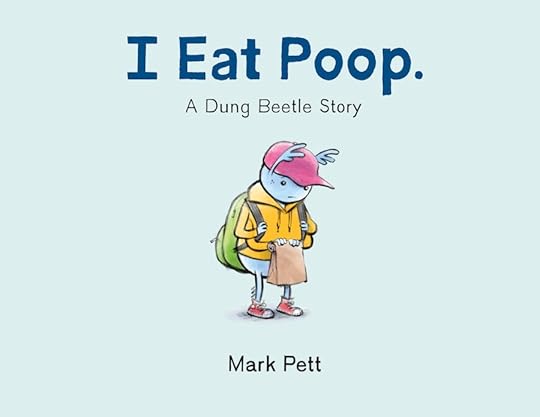 I Eat Poop: A Dung Beetle Story by Mark Pett (3-7 years)
I Eat Poop: A Dung Beetle Story by Mark Pett (3-7 years)“I Eat Poop” is fiction, but I couldn’t give you a list of the best poop books without including this charming, heartwarming, and – yes! – educational book! Here’s the publisher’s short and sweet summary:
A poop-loving dung beetle learns not to hide the quirks that make him special.
Isn’t that a message all of us need to hear now and again?
Bonus Activity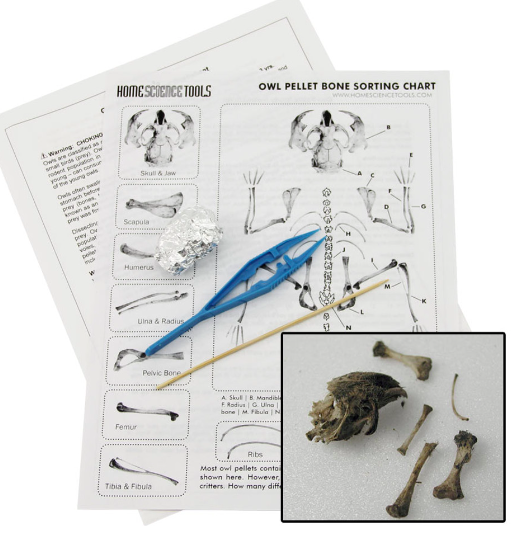 Owl Pellet Dissection Kit
Owl Pellet Dissection KitIf you’ve never dissected owl pellets – you must! It’s a fun, and educational activity that the entire family will enjoy. (And it’s a perfect activity for rainy days or snow days!) Owl pellets don’t resemble poop at all. They’re like dense balls of fur that are full of tiny bones. Looking for the bones with your tweezers is like going on a treasure hunt without ever leaving the kitchen table. The website for this kit says it’s appropriate for ages 8 and up, but younger kids can definitely enjoy this activity with adult supervision. Here’s a description from the website I’ve linked to:
Learn about owls and the little critters they eat by doing an owl pellet dissection!
This hands-on owl pellet kit guides students through an owl pellet dissection. This complete kit comes with a large owl pellet (1-1/2″ or larger), dissection tools, instructions, an identification key, and a bone sorting chart printable for bone identification. It has everything you need for an owl pellet dissection! Each large owl pellet is foil wrapped and dry heat sterilized.
This barn owl pellet dissection kit provides background information, teaching students about food chains and food webs! Examine the inside of an owl pellet to discover the indigestible parts (or bones) of the shrews, voles, and other critters that are eaten by barn owls. The included bone chart helps students to identify jawbones, skulls, and other bits and pieces that help them to further understand and define the different animals in a barn owl’s food web. Owl pellet dissection is an engaging, hands-on life science experience for elementary, middle, and high school-aged students. It is a perfect activity to weave into your life science lesson plans – whether a homeschool parent, a school teacher, or any other kind of science educator.
That’s the list! If you end up taking any of my recommendations, I’d love to hear about it. And if you want more book recommendations for adults, send me a message. You’d be amazed at how many good books there are about human waste, sewers, and wastewater treatment. It’s hard to believe that’s a sentence that I’m typing – and one that I say pretty regularly now, but it’s true! Human waste and what we do with it is an enGROSSing subject!
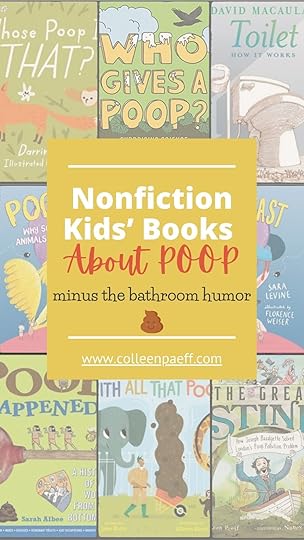
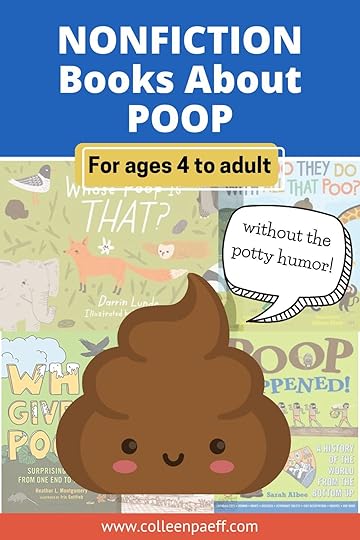
The post The Best Nonfiction Books About Poop (for Kids of All Ages) appeared first on Colleen Paeff.
November 14, 2023
How to Book Free Author & Illustrator Visits on World Read Aloud Day
Once a year, on World Read Aloud Day (WRAD), the kidlit community offers free, 20-minute virtual visits to schools around the world. Here’s how to schedule a visit from your favorite author or illustrator:
Sign up for Kate Messner’s newsletter. She gathers the names and contact information of all the authors and illustrators who participate in WRAD and sends out a Google Doc to her subscribers sometime in November or December.As soon as you get that newsletter from Kate, contact the author(s) or illustrator(s) you’re hoping to book. Slots go FAST, so don’t wait!Log on for your virtual author visit on February 7, 2024 and ENJOY!PRO TIP!Many authors and illustrators who participate in WRAD offer early access to their sign-up sheets to newsletter subscribers. If you have a particular person in mind for WRAD, subscribe to their newsletter list for first dibs!
The post How to Book Free Author & Illustrator Visits on World Read Aloud Day appeared first on Colleen Paeff.
August 24, 2023
Starting a Picture Book Book Club for Grown-ups
I’d dabbled with writing children’s books for more than fifteen years when I finally decided to get serious about writing picture books. My daughter had recently moved out and I chose to fill my empty nest by digging into the world of children’s publishing. Naturally, I turned to the Society of Children’s Books Writers and Illustrators (SCBWI).
I attended Writer’s Days, Agent’s Days, and Editor’s Days. I found a “best” writing friend and a critique group. I attended the summer conference where knowledge, inspiration, and advice were dished out like candy on Halloween. I entered writing contests and I even won a couple!
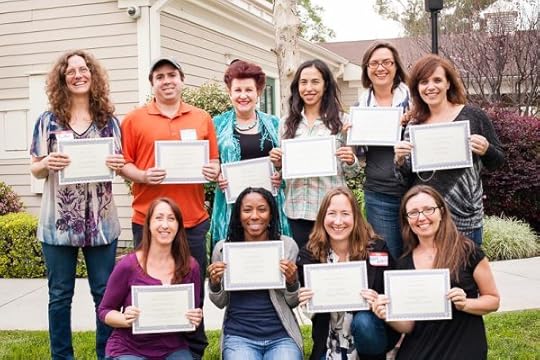
Winners of the 2014 SCBWI-LA Writers Day Contest. I’m on the bottom right. Fun fact: the woman next to me is Kate Korsh. She later became my friend and critique partner, but it wasn’t until years after this picture was taken that we realized we were both winners that day and had sat right next to each other for the photo!
But the best thing I did for myself and my career, was to listen to some excellent advice: “Get to know the industry.”
I decided the best way to do that, would be to start a book club.
It began with a post to the SCBWI-Los Angeles Yahoo group: “Would anyone be interested in joining a monthly picture book club?” I wasn’t sure if I’d get much of a response, but I know myself well enough to know that the secret to reaching a goal is to make sure someone else is relying on me to get there. Even one or two members would mean I’d be more likely to fulfill my objective of learning what makes each publisher unique.
Plenty of people were interested, though. And the Picture Book Publisher Book Club was born.
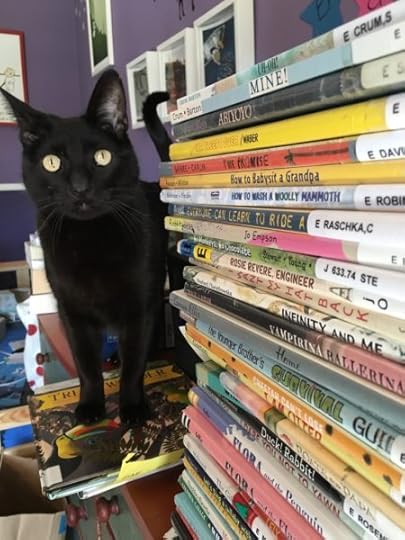
Here’s how it worked: Every month, I’d ask my librarian to print a list of picture books published within the last five years by one particular publishing house. (Each month, I requested books from a different publishing house.) I would put the available book on hold and then, in the beginning, I tried to find out who edited each one. (This became too time consuming, so I stopped.) When the books arrived at my local library branch I would bring a couple heavy canvas bags to the library with me and cart my treasure home.
Then, on the second Saturday of each month, writers and illustrators would come to my house and we’d read as many books as we could, trying to discern a common thread among them.
Armed with the knowledge we gained, those of us without agents were better equipped to submit directly to editors, and all of us, agented and unagented alike, got an excellent education in the children’s publishing market of today.
As an added bonus, thanks to the book club, my community has grown by leaps and bounds – and many of us are published now!
Starting a picture book book club is one of the best steps you can take to further your writing career and community. Here’s how to do it:Reach out to friends, family, your local SCBWI chapter, and possibly even your librarian to find fellow picture book people who are interested in joining your book club, then set a regular monthly meeting date.About two weeks before your meeting, ask your local librarian to give you a print out of books carried by the library and published within the past three to five years by whichever publisher you are reading that month. (In the early days of our meetings we chose publishers who accepted unagented manuscripts because most of us were unagented at the time.)Once I have the list, use a combination of the library website, Amazon, and the publishing house’s website to determine which books fit your criteria for the month. (For example, we only wanted picture books and we didn’t want any books that we couldn’t ead at the meeting.)Put the books you’ve chosen on hold via the library website. Have them delivered to your local library branch, if possible. (I usually requested 25-30 books, though we rarely got through all of them.)Once they’ve arrived, check the books out and, if you have the time and inclination, try to find out who edited them. I used to use a combination of Google searches, SCBWI resources, and author notes or dedications in the books themselves. (This job is best split up between several people.)At the meeting, take turns reading the books aloud. (Story time for grown-ups!) Look for common themes, subjects, or writing and illustration styles, so you come away with a sense of what makes this publisher’s books unique.Decide on a publisher for the following month. Repeat!That’s it! Let me know if you start one and how it goes.
Happy reading!
Colleen
The post Starting a Picture Book Book Club for Grown-ups appeared first on Colleen Paeff, Author of Books for Children.
August 2, 2023
From Idea to Sale: A Picture Book Tale
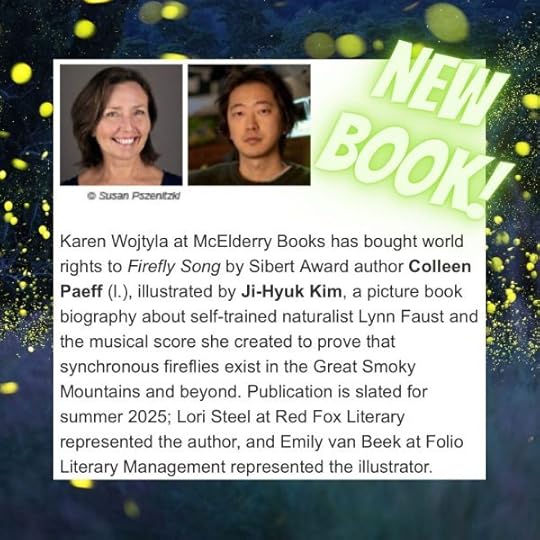
I am thrilled to share the news that I have a third picture book coming out! Firefly Song tells the story of how former citizen scientist (and current firefly expert) Lynn Faust discovered a species of synchronous fireflies in the Smoky Mountains. I first read about Lynn in 2014 in an article from Mental Floss magazine titled “The Great Smoky Mountains’ Incredible Firefly Light Show.” This is how the article, written by Jen Doll, starts:
At exactly 9:27 P.M., when dusk slips into darkness in the Great Smoky Mountains National Park, the “light show” begins. It’s June, and for two weeks in Elkmont, Tennessee, the fireflies pool their efforts. Instead of scattershot blips of light in the summer sky, the fireflies—thousands of them—pulse this way for hours, together in eerie, quiet harmony. It’s as if the trees were strung up with Christmas lights: bright for three seconds, dark for six, and then bright again, over and over. It continues this way for hours.
As a child, Lynn Faust would huddle with her family on the cabin porch to watch the spectacle. They’d sit, mesmerized by the “drumbeat with no sound.” And though they’d appreciated the show for generations, Faust never thought the event was newsworthy. “I’d assumed there was only one kind of firefly and thought they did a nice show in the Smokies,” she says.
The natural world has long enchanted Faust. In college, she majored in forensic anthropology and minored in forestry. In her twenties, she circumnavigated the globe for three years, visiting islands you could only get to by boat, learning about cultures before they disappeared, pursuing underwater photography. Today, at 60, she’s a naturalist who writes scientific papers and field guides about fireflies. But she wasn’t always obsessed with the insect. In fact, her academic interest began only in the ’90s, when she read an article by Steven Strogatz, a Cornell mathematician, in which he marveled at a species of Southeast Asian firefly that synchronized its flashes. Highlighting how rare this phenomenon was, Strogatz noted that there were no synchronous fireflies in the Western Hemisphere.
This struck Faust as odd. It contradicted the light shows she had seen growing up. As she dug deeper, Faust found that while there had been more than 100 years of colloquial accounts of North American fireflies flashing in sync, scientists discounted those reports, attributing them to lore or optical illusion. Faust knew the truth: that her Tennessee fireflies were every bit as special as the species in Asia. But how could she prove it?
Doesn’t that sound like a perfect picture book!? I knew right away that I wanted to write Lynn’s story. There was just one problem.* I didn’t have any published books under my belt. I’d done some magazine articles and I’d written a monthly newspaper column for the past seven years, but I didn’t consider myself a “Real Author.” I was afraid if I approached Lynn, she’d look at my measly credits and say no. So, I folded up the article, tucked it away, and decided to contact her once I had a book contract. Four years later, in 2018, I sold my first book. Achievement unlocked! I was a “Real Author.” (Woohoo!!) Three years after that, I finally had a book cover and some interior sketches (by the incredibly talented illustrator Nancy Carpenter) to share, so I sent Lynn an email.
“Dear Ms. Faust,” I wrote. “Hello! I hope you and your family are doing well during this strange time. I am a children’s book author. My debut picture book, The Great Stink: How Joseph Bazalgette Solved London’s Poop Pollution Problem, comes out on August 31 from Margaret K. McElderry Books, an imprint of Simon and Schuster, and I have a second book about a Pakistani decorated truck coming out from Chronicle Books in 2023.** I would very much like for my third book to be about you.”
I went on to explain how I thought children would love reading about her summers spent in the Smoky Mountains; and how, even though she didn’t study entomology in school, she astounded the scientific community with the realization that North America does, indeed, have synchronous fireflies. “Given that there’s a big need for picture books about women in STEM,” I wrote, “and that this particular book would have the added bonus of including information about a beloved insect, I think it will be a hit!” I also attached an article I had written for an Iowa City newspaper about the first time I ever saw a firefly. I hoped it would show her I was a true firefly fan!

Lynn responded to my email that very same day – AND SAID YES! Over the next year we spoke via WhatsApp and Zoom. We exchanged emails. I interviewed some of her family members and research partners. I devoured her wonderful book on North American fireflies, underlining especially fascinating facts and making copious notes in the margins. Lynn sent me photos from her childhood, college years, time as a young mother, and as a field researcher. She shared pictures of fireflies with me, and when I traveled to England, she gave me tips on where I’d be most likely to spot fireflies (near water in an area with lots of vegetation). I didn’t find any, but Lynn was proud of me for trying! I signed a contract for Firefly Song in early 2022 and that same year, I had the great pleasure of meeting Lynn face-to-face in the very place where she started her firefly journey – Elkmont, Tennessee. Even better, my husband came along and we got to see Lynn’s synchronous fireflies for ourselves!
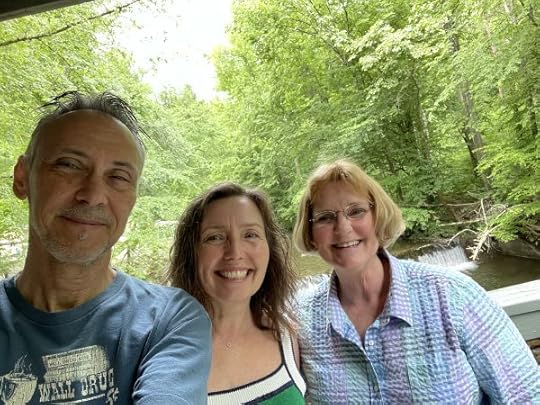
My husband Warren (left), me, and Lynn Faust in the Smoky Mountains of Tennessee.
Our first day there, Lynn gave us a grand tour of Elkmont. It’s considered a ghost town now, but for decades it was a summer getaway for families from the city. Lynn spent childhood days wandering through the forest, wading in the creek, and jumping into the swimming hole. It was a beloved home away from home for most of her life – until 1992 when the park took possession of the cabins and eventually tore most of them down. It was incredible to see the place Lynn had told me so much about. The cottage where she first saw the synchronous fireflies (which had belonged to her husband’s family) was long gone. Only its chimney and the stone wall that surrounded it remained.
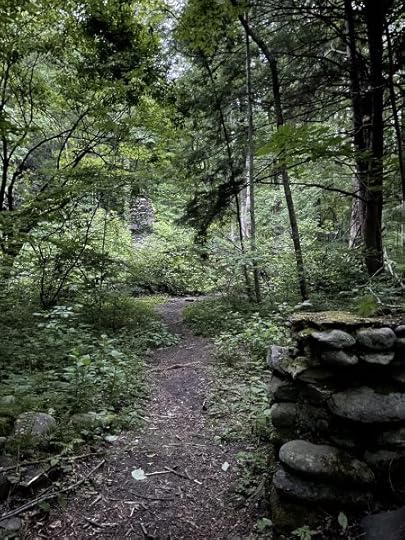
Looking towards the Faust cabin from the stone wall that surrounded it.
But luckily the cottage where Lynn spent much of her childhood was still standing and had been restored, along with a handful of other cabins.
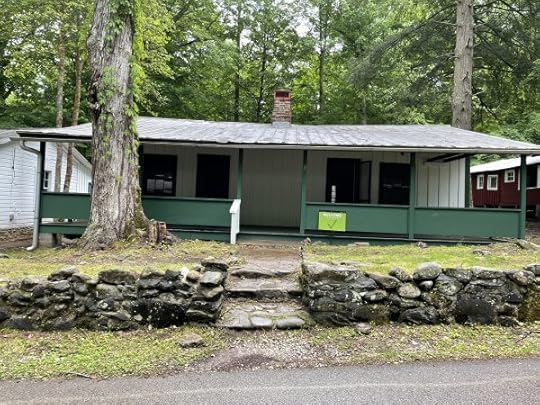
The cottage Lynn’s parents shared with close family friends, the Mayos.
Lynn entertained us with stories of skunks wandering into cabins, bears picking apples from trees, and fireflies (of course!) lighting up the hillsides. Later that night, Warren and I came back to see the fireflies for ourselves. We met Lynn in the parking lot and she led us up a long trail to a spot where she expected the show would be good.
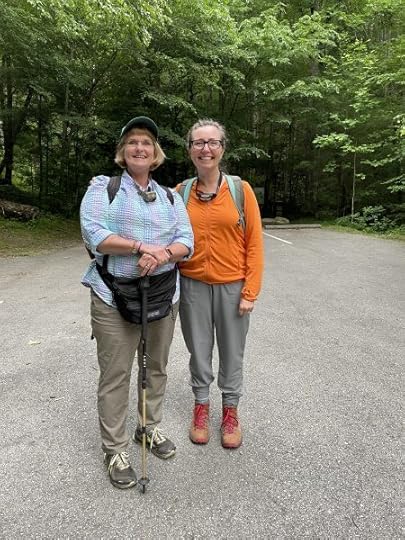
Lynn and me ready for a night of firefly watching.
We were not disappointed! It was amazing to watch the air come alive with twinkling lights then go completely dark seconds later, as if a light switch had been flicked off. Though the Smoky Mountain synchronous fireflies (Photinus carolinus to the scientists) were the main attraction, Warren and I also loved watching the tiny Blue Ghost fireflies. They flew about a foot off the ground with a steady bluish light in search of potential mates on the forest floor. One of them flew right over my shoe, creating a tiny spotlight as he passed! I don’t have any photos of the Light Show, but this video will give you some sense of what it’s like. If you really want to understand the majesty of these incredible insects, you need to see the show for yourself! Barring that, in the summer of 2025, you can read Firefly Song!
My fabulous editor, Karen Wojtyla, had the job of finding an illustrator for the book. She needed an artist who excelled at illustrating light and landscapes – someone who could capture the special magic of the Smokies alight with firefly lanterns. And boy did she ever find the perfect person! Ji-Hyuk Kim has illustrated several picture books and created many book covers, including Christina Soontornvat’s Newbery Honor book A Wish in the Dark. (I love this book cover and I love the book!)
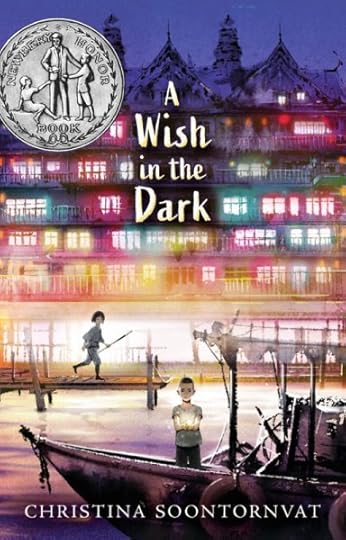
Take a quick scroll through his website, and you’ll understand why I was so happy to discover he’d be the artist bringing Lynn’s story to life. I can’t wait to see it!
So, that’s the story of how Firefly Song came to be. If you want to receive occasional information on my upcoming books (cover reveals, release dates, preorder info, etc.) and other good news, please consider signing up for my newsletter.
In the meantime, if you’re lucky enough to live in an area with fireflies, grab a copy of Fireflies, Glow-worms, and Lightning Bugs by Lynn Faust and get outside after dark! You’ll be amazed when you learn how many different species of fireflies exist and how you can best identify them. Just be careful. When you read about the females of the Photuris genera, you’ll never look at fireflies the same way again! (And if you follow that link you can never unsee those photos. You’ve been warned!)
Thanks for reading!
Colleen
____________________________________________________
*Whether this was truly a problem or not is a subject for another blog post!
**Rainbow Truck is now scheduled to be released in 2024.
The post From Idea to Sale: A Picture Book Tale appeared first on Colleen Paeff, Author of Books for Children.
March 2, 2022
Author Visit Tip: Ask Students for Feedback
[Please see my School Visits page or download my school visit information packet for details on bringing me and my award-winning book, THE GREAT STINK, to your school. I would love to meet you and your students!]
The very first time I visited a school as an author, I wanted to know what the kids thought of my brand new presentation, so I asked. We had already talked about how to give critiques, so this was their opportunity to use what I’d taught them about giving feedback right away –– on me! It turned out to be a great idea, one that I still use in my presentations to this day, when time permits. If you’re an author just starting to do school visits, I highly recommend asking the students what they thought of your presentation (with the teacher’s permission, of course!).
Keep reading for a full rundown of those first school visits, or scroll down to find out what sentence-starters I gave the students and what they had to say about my presentation.
Last month, I went home to Los Angeles where I did some free school visits to practice my author presentations, and to prove to myself that I would not become a big ball of nerves and die when faced with a room full of 4th graders. Spoiler alert: I survived! I think you could even say I thrived. It was amazing!
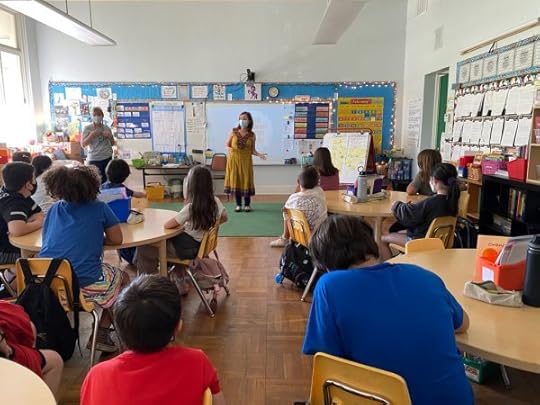
I visited two schools in person and two schools virtually (for a total of seven presentations). The night before my first visit I couldn’t sleep. I kept asking myself why (“Why? Why?! WHY?!?!”) had I offered to do any school visits at all. Never mind that I had taught preschoolers and homeschoolers and presented at conferences. It didn’t matter that I had trained as an actor many moons ago or that I’d been a member of Toastmasters and had the blue ribbons to prove it. I was sure I would bore the kids to tears. And I felt there was a good chance I might cry, too.
But thank goodness for wise and funny friends who are authors. When I shared my concerns, Kelly Carey told me, “At least if you poop your pants, you’ll be on brand!”–which is horrifying and true. And Elisa Boxer said, “Focus less on the presentation and more on connecting with [the students].” This combination of levity and simple, straightforward advice on making connections rather than “presenting” turned out to be just what I needed.
Each school visit was different, but the one thing they all had in common, was that I LOVED every second of interacting with the kids. At my first in-person visit–a class of 4th graders–I gave the students some handouts that offered five sentence-starters and asked them to critique my presentation. This turned out to be a stroke of genius on my part because the students’ feedback ran the gamut from helpful to hilarious–and it included lots of very welcome praise, too.
Here’s some of the feedback I received:
Something I liked about the presentation was…
…it was packed with info on how you made your book.
…I liked that you had the confidence to come and tell us about your life.
…that you told us about how you get inspired.
…when you explained how you found the topic.
…when you answered questions and when you showed some of your challenges and how you fixed those.
…the amazing details.
…I loved all of it.
I started to lose interest when…
…you passed around the pictures because it took a long time for everyone to see them.
…you told us about the research–it was just a lot of information.
…when you called on so many people.
…I didn’t lose interest.
I wanted to know more about…
…why you wrote about a poop problem out of all the things.
…how you found the research.
…how you wrote all your drafts.
…your struggles because I struggle a lot in writing.
…what was the main thing that keeped you going when you were writing this book?
…your trip to London.
…the first time you wrote.
I was confused when…
…I wasn’t confused because you explained everything in your presentation, so keep doing that.
…I thought that you drew the pictures.
…you said that writing the whole book was hard because there has to be at least one part where you felt really good and strong about.
…I was not confused. You said it clearly. Don’t be nervoes you did amazing.
…the guy was swimming in the poop.
My favorite part was…
…when the guy was swimming in the poop.
…when you talked about where you traveled to write “The Great Stink.”
…when you shared great tips for writing.
…when you told us how you organized your research because it was very strong.
…when we got to see the original illustrations.
…when you showed us the super stinky draft.
…when you showed us your cat.
…everything. No joke.
It turned out to be really valuable information–and not just because so much of it was positive! The next time I presented to a class, I changed the section on research, based on what some of the kids had said. I think the presentation was better because of it. I also know now not to pass around pictures while I’m talking. It’s too distracting. So the kids let me know what I should think about changing and what I was doing right. I couldn’t have asked for anything better from my own critique group!
Now that I’ve conquered author visits in California, I’m taking the show on the road to London! I’ve already got three author visits lined up for late March, as well as a book reading and signing event at the Crossness Pumping Station on March 20!
If you know any teachers or librarians in the UK who would be interested in a free virtual visit (entire UK) or an in-person author visit (greater London area only) the week of March 21-25, please let me know. And if you’re not too far from Crossness, I hope to see you there on the 20th!
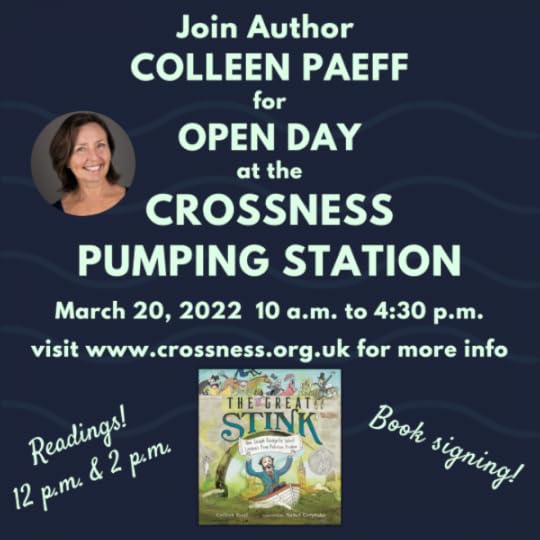
The post Author Visit Tip: Ask Students for Feedback appeared first on Colleen Paeff, Author of Books for Children.
December 15, 2021
World Read Aloud Day 2022
World Read Aloud Day is coming up on February 2, 2022!
For the first time ever, I am joining millions of book lovers around the globe as we celebrate the power of reading aloud with World Read Aloud Day, held annually on the first Wednesday of every February.
I am so looking forward to connecting with students and teachers on this very special day. Should you choose to sign up, here’s what our 20-minute WRAD virtual visit will look like:
1-2 minutes: Hello! I’ll introduce myself and my book.
3-5 minutes: Let’s read! I’ll read a short picture book or a short excerpt from a longer picture book aloud.
5-10 minutes: Q&A time! I’ll answer some questions from students about reading, writing, or creating books.
1-3 minutes: Read this! I’ll recommend some books I love (but didn’t write!).
Ready to celebrate reading aloud? Book me for a free 20-minute virtual visit here:
https://forms.gle/a2kqqfz4Df9HFHFR7
See you in February!
Colleen

The post World Read Aloud Day 2022 appeared first on Colleen Paeff, Author of Books for Children.
November 9, 2021
Picture Books about Infrastructure
We tend not to think about things like bridges and roads, or water treatment, and sanitation facilities unless something goes wrong, but cities can’t function without them. Healthy infrastructure means healthy citizens! To celebrate the passing of the infrastructure bill, here’s list of picture books to help young readers learn about infrastructure:
Someone Builds the Dream by Lisa Wheeler, illustrated by Loren Long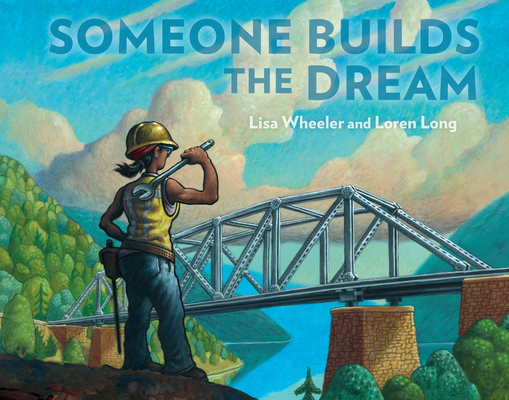
Dial Books, 2021; ages 5 – 8
Underground: Subway Systems Around the Worldby Uijung Kim
Cicada Books, 2020; Ages 3 – 9
I am the Subwayby Kim Hyo-Eun, translated by Deborah Smith
Scribble US, 2021; ages 3 – 7
Secret Engineer:How Emily Roebling Built the Brooklyn Bridgeby Rachel Dougherty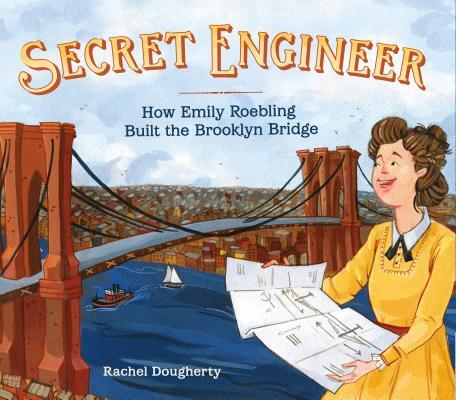
Roaring Brook Press, 2019; Ages 5 – 8
The Boy Who Harnessed the Windby William Kamkwamba and Bryan Mealer, illustrated by Elizabeth Zunon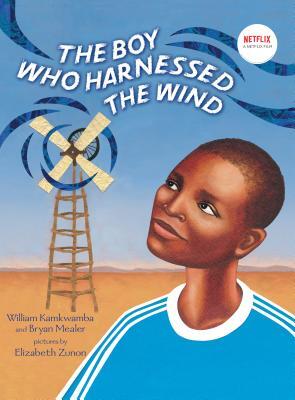
Dial BFYR, 2012; Ages 6 – 8
The Great Stink:How Joseph Bazalgette Solved London’s Poop Pollution Problemby Colleen Paeff, illustrated by Nancy Carpenter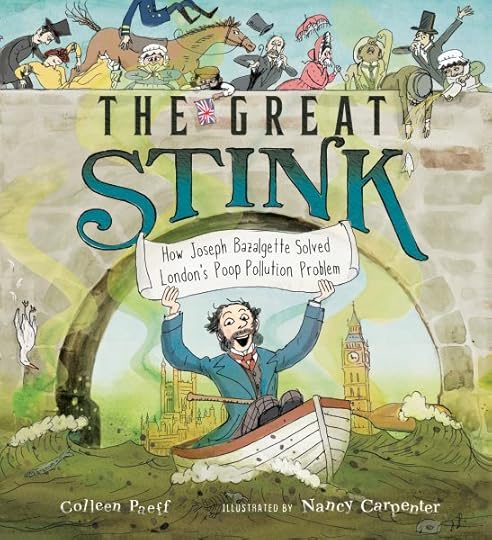
Margaret K McElderry Books, 2021; Ages 4 – 8
Energy Island:How One Community Harnessed the Wind and Changed Their Worldby Allan Drummond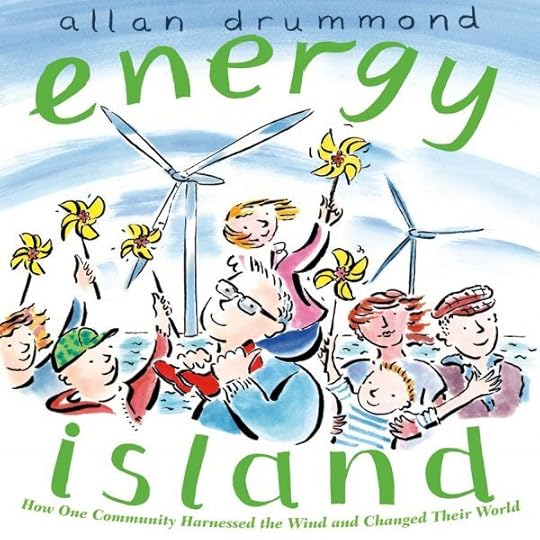
Square Fish, 2015; Ages 6 – 10
Undergroundby David Macaulay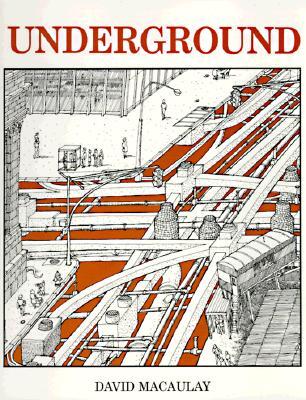
Clarion Books, 1983; Ages 10 – 12
Roadworkby Sally Sutton, illustrated by Brian Lovelock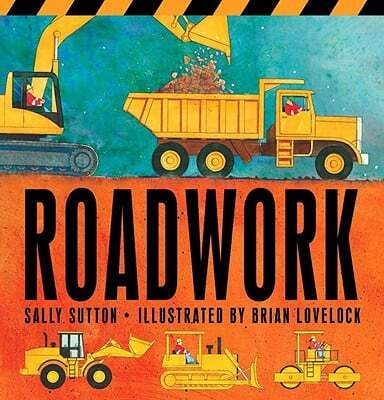
Candlewick Press, 2011; Ages 2 – 5
The Magic School Bus at the Waterworksby Joanna Cole, illustrated by Bruce Degen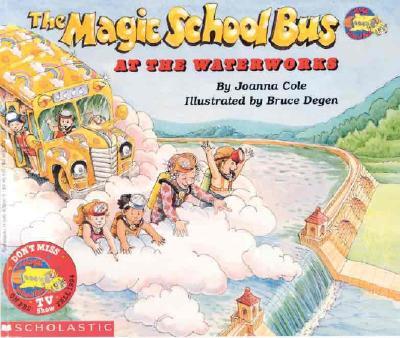
Scholastic Press, 2004; Ages 4 – 8
Dreaming Up:A Celebration of Buildingby Christy Hale
Lee & Low Books, 2012; Ages 4 – 7
Building Our Houseby Jonathan Bean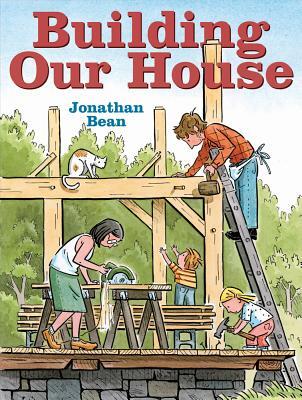
Farrar, Straus and Giroux, 2013; Ages 3 – 6
Wiredby Anastasia Suen; illustrated by Paul Carrick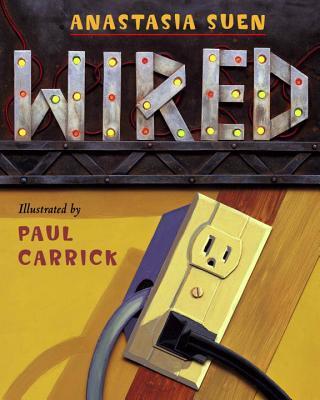
Charlesbridge, 2007; Ages 6 – 9
Opening the Road:Victor Hugo Green and his Green Book*by Keila V. Dawson; illustrated by Alleanna Harris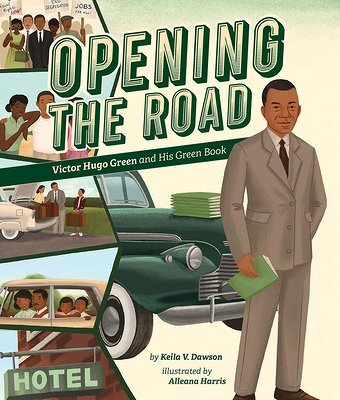
Beaming Books, 2021; Ages 4 – 8
I am Farmer:Growing an Environmental Movement in Cameroonby Baptiste and Miranda Paul; illustrated by Elizabeth Zunon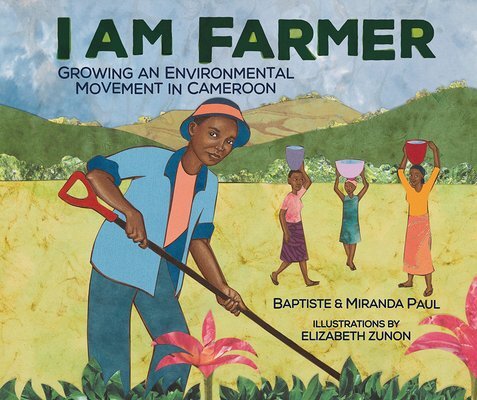
Millbrook Press, 2019; Ages 7 – 11
Billions of Bricks:A Counting Book about Buildingby Kurt Cyrus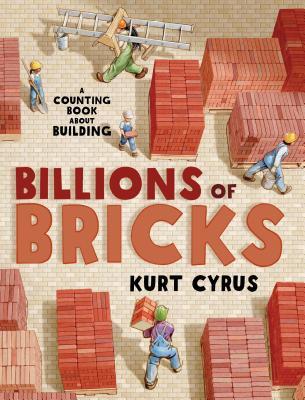
Henry Holt & Co, 2016; Ages 4 – 7
Builders and Breakersby Steve Light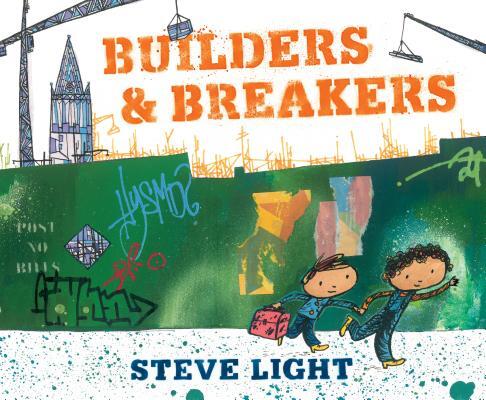
Candlewick, 2018; Ages 3 – 7
The Secret Subwayby Shana Corey; illustrated by Red Nose Studio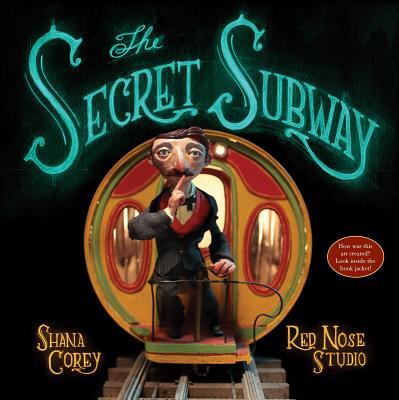
Schwartz & Wade, 2016; Ages 4 – 8
When Jackie Saved Grand Central:The True Story of Jacqueline Kennedy’s Fight for an American Iconby Natasha Wing; illustrated by Alexandra Boiger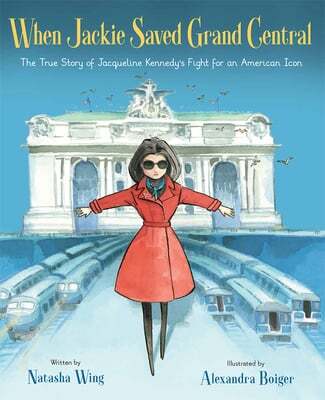
Clarion Books, 2017; Ages 6 – 9
Up! Up! Up! Skyscraperby Anastasia Suen; illustrated by Ryan O’Rourke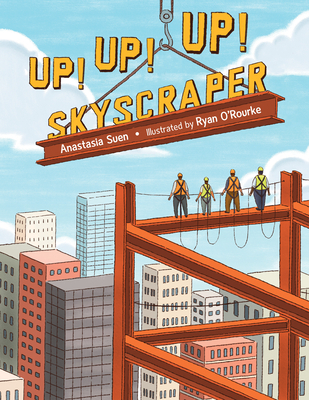
Charlesbridge, 2021; Ages 3 – 7
*Social infrastructure. Start an interesting discussion with your students or children about different types of infrastructure and why they’re necessary.
The post Picture Books about Infrastructure appeared first on Colleen Paeff, Author of Books for Children.
September 4, 2021
Watch THE GREAT STINK Virtual Launch Party
The post Watch THE GREAT STINK Virtual Launch Party appeared first on Colleen Paeff, Author of Books for Children.

